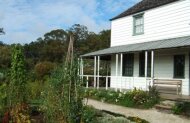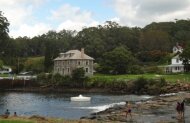Kerikeri
Kerikeri holds a significant place in New Zealand's history, being the site of the country's second mission, established in 1819. Overlooking the Kerikeri Inlet, you'll find two of New Zealand's most iconic and oldest surviving buildings: the Stone Store (1833), the country's oldest stone building, and Kemp House (1822), its oldest wooden structure. Both have been meticulously restored and offer fascinating insights into early colonial life. Across the water, Hongi Hika's fortified pā also welcomes visitors, connecting you to Māori heritage.
Beyond its rich past, Kerikeri is also known for its natural beauty, including the picturesque Rainbow Falls, a stunning multi-tiered waterfall just a short drive from the town centre. Today, Kerikeri is also celebrated for its lush fruit orchards and a vibrant fine arts and crafts scene. Discover the unique blend of history, natural beauty, and contemporary culture that makes Kerikeri a truly special destination.

Kemp House
Kemp House also known as Kerikeri Mission House is New Zealand's oldest European building. Built by the London-based Church Missionary Society in 1821 to 1822 with the help of local Maori, it was situated under Ngapuhi Pa and was under the protection of the local tribal chief Hongi Hika. The 2 storey Georgian designed building was built primarily from Kauri. You can visit Kemp House on guided tours, highlights include the garden which has been cultivated since 1820 and is in a similar style to the original garden, as well as furnishings and personal wares from the last missionary family to live here, James Kemp and his wife Charlotte, who went on to purchase Kemp House after the missionary closed and ran a Kauri gum business out of the historic Stone Store.

Stone Store
The Stone Store is New Zealand's oldest stone building and was completed in 1836. It was designed by Wesleyan missionary John Hobbs and built by William Parrot an ex-convict stonemason from New South Wales. Originally designed to be the base for the missionaries trading post and for storage of their produce, as this wasn't profitable, the store was used for other purposes. These included a brief stint as the missionary library and as the magazine and barracks for Governor George Grey's troops during the first Maori war, it eventually was bought by the Kemp family who used it as a kauri gum trading store, then a general store. Today you can see artefacts and displays of its history, and purchase heritage-related gifts.